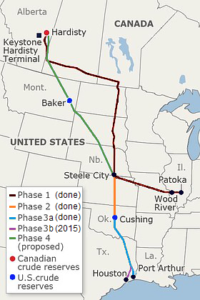It’s been a mix of good news and bad news for Keystone XL Pipeline supporters. On January 29, 2015, the U.S. Senate approved S.1, the Keystone XL Pipeline Approval Act, by a 62-36 vote. On February 11, the House of Representatives voted 270 to 152 to approve the act, which would finally allow construction of the controversial pipeline project. The measure then moved to the White House, where President Barack Obama is expected to veto it.
Although the bill found support across party lines, it did not receive the two-thirds majority in either chamber needed to override the president’s probable veto.

Keystone Pipeline route courtesy of Wikipedia user Meclee, CC BY-SA 3.0.
Meanwhile, a court in Nebraska has thrown another wrench in the gears just weeks after it appeared the pipeline was moving forward. We’ve discussed the legal battle in Nebraska before, but to review, in January 2012, the Nebraska Legislature passed L.B. 1161, which allowed the State Governor to approve the use of eminent domain to construct an oil pipeline. In March 2013, a group of landowners challenged the constitutionality of the bill, and the Lancaster County District Court agreed. The State appealed, and on January 9, 2015, the Nebraska Supreme Court vacated the district court’s decision because not enough members of the court were willing to declare L.B. 1161 unconstitutional. That decision was expected to allow TransCanada to construct the pipeline along the route that was first approved by Governor Heineman 2 years ago, assuming that federal approval could also be obtained.
However, on January 16, seven more landowners filed suit in York and Holt Counties challenging the constitutionality of L.B. 1161 and seeking temporary injunctions until their cases are resolved. On February 12, a Holt County District Court judge issued a temporary injunction preventing the use of eminent domain to force landowners along the proposed route to sell TransCanada pipeline easements on their property. Pipeline opponents see the ruling as a victory and one more way to postpone the Keystone XL Pipeline.
A representative for TransCanada said that the company is going to push for a trial as soon as possible to resolve the issue. In the meantime, TransCanada is halting eminent domain proceedings until the courts work through this latest wrinkle. The company noted that they have followed every protocol and request from every level of government since starting the approval process more than 6 years ago.
For now, it appears that pipeline proponents will have to work through the court system while at the same time maneuvering through political channels to get the project completed. Obama has said he will veto the pipeline because it should be the president’s decision whether to approve the pipeline. The 1,179-mile-long, 36-inch-diameter proposed pipeline extension would move crude oil from Alberta, Canada as well as from the Bakken oil fields in Montana and North Dakota to Steele City, Nebraska. From there, it would connect to the existing Keystone Pipeline system, which runs to refineries in the Midwest and the Gulf Coast. Because it crosses an international border, the Keystone XL Pipeline requires a Presidential Permit.
The president has stated that his main concern is the risk to the environment, an issue the State Department is supposedly still investigating. However, the State Department’s Final Supplemental Environmental Impact Statement for the Keystone XL Project was published January 31, 2014, concluding that the proposed project would be safer and have fewer environmental risks than the No Action Alternative, which would require the oil to be transported by other means such as train or tanker truck. The public comment period ended on March 7, 2014, but no Record of Decision or Presidential Permit has been issued.
Environmentalists say that drilling in tar sands releases more carbon and can cause more issues in the environment along the pipeline if there is a spill. Proponents argue that the drilling will occur with or without the pipeline, and the pipeline will add jobs to an economy that is still recovering.
Check back for updates on the Keystone XL Pipeline as they develop.





Recent Comments